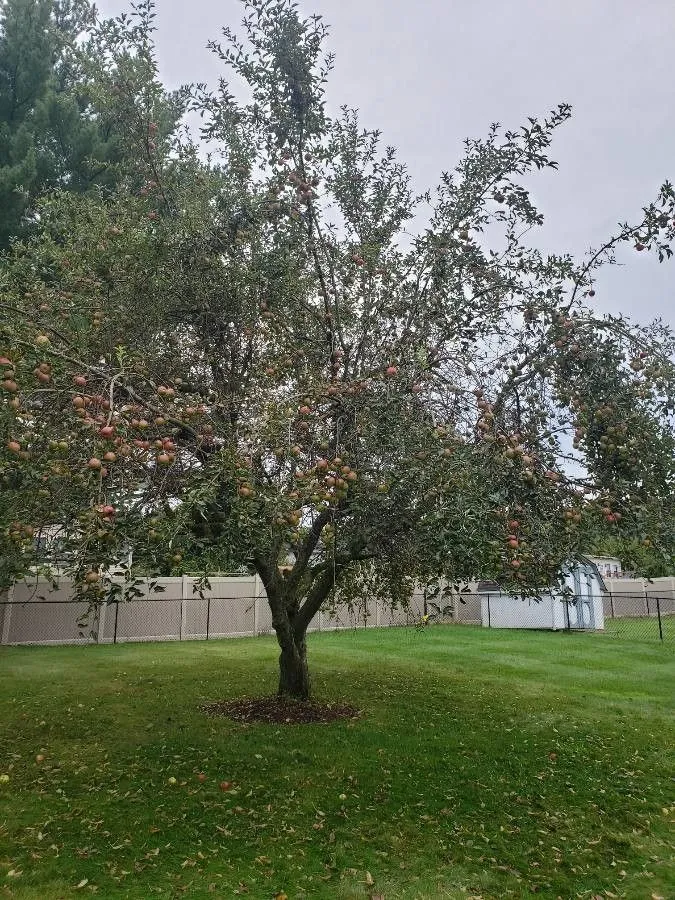
Author: Mill.
Bibliography: Gard. dict. ed. 8: Malus no. 3. 1768
Year: 1803
Status: accepted
Rank: species
Genus: Malus
Vegetable: False
Observations: Unknown
Paradise apple, scientifically known as Malus pumila, is a captivating member of the Rosaceae family. Despite being prominent in various gardening and botanical references, particularly noted in the authoritative “Gard. dict. ed. 8: Malus no. 3. 1768” by Mill., the species still retains an air of mystery with several observations about it remaining undiscovered or unrecorded.
This plant showcases a remarkable resilience and adaptability to different environments, making it a favorite among horticulturists and home gardeners alike. Renowned for its vibrant and lush foliage, Paradise apple contributes significantly to the aesthetic value of gardens, providing splashes of color and a sense of vitality.
The plant tends to grow with a compact and symmetrical canopy, adorned with glossy green leaves that turn into a stunning display of reds and yellows in the autumn. In spring, Paradise apple produces a profusion of delicate, fragrant blossoms that attract pollinators such as bees and butterflies, contributing to the richness of the local ecosystem.
The fruit of the Paradise apple, though smaller than the typical commercial apples we are accustomed to, boasts a unique flavor profile that combines sweetness and tartness, making it a delightful treat for those who cherish natural produce. These fruits are often utilized for making preserves, jellies, and even enjoyed fresh as a healthy snack.
Cultivating Malus pumila demands moderate understanding of soil preferences and watering practices. It thrives best in well-drained soils with a neutral to slightly acidic pH and requires regular watering during the growing seasons. However, it is relatively drought-tolerant once established, making it a low-maintenance addition to any garden.
Pests and diseases do occasionally pose a threat, as with other members of the Rosaceae family, but with proper care and timely interventions, these can be managed effectively. Regular pruning is recommended to maintain its shape and promote healthy growth.
In conclusion, the Paradise apple is more than just a plant; it is a testament to nature’s beauty and resilience. Though some observations about this fascinating species remain unknown, its evident charm and practicality ensure that it continues to be cherished in gardens around the world.
En: Paradise apple, Apple, Kulturapfel, Common apple, Apple Tree, Cultivated Apple, Ping guo
Af: Appel
Ar: تفاح قزم
Hy: Խնձորենի այգու
Az: Mədəni alma ağacı
Eu: Sagarrondo
Bn: মালুস পুমিলা
Bs: Jabuka
Bg: Ниска ябълка
Ca: Pomera
Zh: 蘋果
Cs: Jabloň nízká
Da: Almindelig Æble
Nl: Appel
Eo: Kulturpomo
Et: Madal õunapuu
Fi: Eevanomenapuu, Paratiisiomenapuu, Tarhaomenapuu
Fr: Pommier paradis, Pommier domestique, Pommelier, Pommier commun, Pommier cultivé, Pommier nain
Gl: Maceira
De: Paradies-Apfel, Garten-Apfel, Kultur-Apfel, Kultur-Apfelbaum
El: Μηλιά
It: Melo comune
Jv: Apel
Ko: 사과나무
Ku: Sêv
Lv: Ābele
Mk: Јаболко
Ms: Epal
Mn: Алим
Ne: स्याउ
No: Eple
Oc: Pomièr
Pl: Jabłoń domowa
Pt: Macieira, Maçã
Qu: Mansana
Ro: Măr
Ru: Яблоня домашняя
Gd: Craobh-ubhal, Craobhan-uabhal
Sr: Домаћа јабука
Sk: Jabloň domáca
So: Tufaax
Es: Jablana, Manzano
Zh-tw: 蘋果
Tt: Йорт алмагачы
Te: ఆపిల్
Bo: ཀུ་ཤུ།
Uk: Яблуня райська
Uz: Olma
Cy: Afal, Coed Afalau, Coeden Afalau, Pren Afalau
Taken Aug 3, 2019 by Alaphasiac (cc-by-sa)
Taken Jul 21, 2021 by William Coville (cc-by-sa)
Taken Jul 21, 2021 by William Coville (cc-by-sa)
Taken Feb 27, 2022 by Shelley Brown (cc-by-sa)
Taken Feb 27, 2022 by Shelley Brown (cc-by-sa)
Taken May 15, 2021 by Maite Lezama (cc-by-sa)
Taken Aug 9, 2020 by Torsten proft (cc-by-sa)
Taken May 22, 2018 by sarator (cc-by-sa)
Taken Apr 10, 2019 by PlantHunter (cc-by-sa)
Taken May 20, 2018 by Raphaël Nal (cc-by-sa)
Taken Apr 28, 2015 by Samuel Dufour-Kowalski (cc-by-sa)
Taken Apr 28, 2015 by Samuel Dufour-Kowalski (cc-by-sa)
Taken Jul 25, 2021 by William Coville (cc-by-sa)
Taken Sep 9, 2021 by Anthony Fernandez (cc-by-sa)
Taken May 8, 2021 by Splam Bo (cc-by-sa)
Taken May 31, 2022 by Roberto Picciau (cc-by-sa)
Taken Sep 13, 2022 by Guillermo Garcia (cc-by-sa)
Taken Jun 9, 2022 by Ribeiro Antônio (cc-by-sa)
Taken Feb 9, 2022 by Oliveira Vander (cc-by-sa)
Taken Feb 27, 2022 by Shelley Brown (cc-by-sa)
Taken Apr 28, 2015 by Samuel Dufour-Kowalski (cc-by-sa)
Taken Nov 7, 2021 by Emmanuel Valderrama (cc-by-sa)
Taken Apr 16, 2021 by Daniela Gallardo (cc-by-sa)
Taken Nov 1, 2021 by Jordan DeGuia-Urgo (cc-by-sa)
Taken Sep 9, 2021 by Anthony Fernandez (cc-by-sa)
Taken Aug 9, 2020 by R. de Castro Ricardo (cc-by-sa)
Taken Apr 12, 2022 by Ghost Weber (cc-by-sa)
Taken May 23, 2021 by fumus ubi (cc-by-sa)
Taken May 15, 2022 by pat98 (cc-by-sa)
Taken Aug 17, 2014 by Tela Botanica − Philip Tatham (cc-by-sa)
Growth form: Multiple Stem
Growth habit: Tree
Growth rate: Moderate
Ph maximum: 7.5
Ph minimum: 5.0
Light: 7
Atmospheric humidity: 5
Soil nutriments: 4
Family: Myrtaceae Author: (F.Muell.) K.D.Hill & L.A.S.Johnson Bibliography: Telopea 6: 402 (1995) Year: 1995 Status:…
Family: Rubiaceae Author: Pierre ex A.Froehner Bibliography: Notizbl. Bot. Gart. Berlin-Dahlem 1: 237 (1897) Year:…
Family: Sapindaceae Author: Koidz. Bibliography: J. Coll. Sci. Imp. Univ. Tokyo 32(1): 38 (1911) Year:…
Family: Asteraceae Author: A.Gray Bibliography: Pacif. Railr. Rep.: 107 (1857) Year: 1857 Status: accepted Rank:…
Family: Fabaceae Author: Medik. Bibliography: Vorles. Churpfälz. Phys.-Ökon. Ges. 2: 398 (1787) Year: 1787 Status:…
Family: Aspleniaceae Author: (Cav.) Alston Bibliography: Bull. Misc. Inform. Kew 1932: 309 (1932) Year: 1932…